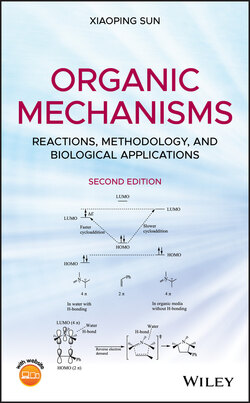Читать книгу Organic Mechanisms - Xiaoping Sun - Страница 13
1.2 ELEMENTARY (CONCERTED) AND STEPWISE REACTIONS
ОглавлениеSome chemical reactions only involve one microscopic step. In these reactions, the effective molecular collision, the collision of reactant molecules with sufficient energy in appropriate orientation, leads to simultaneous breaking of old bonds in reactants and formation of new bonds in products. This type of reactions is defined as elementary (or concerted) reactions. An elementary (concerted) reaction proceeds via a single transition state. The transition state is a short‐lived (transient) activated complex in which the old bonds are being partially broken and new bonds are being partially formed concurrently. It possesses the maximum energy level (in the free energy term) in the reaction profile (energy profile).
Many other chemical reactions involve many microscopic elementary (concerted) steps in the course of the overall reactions. These reactions are defined as stepwise (or multistep) reactions. A stepwise reaction proceeds via more than one transition state. Each microscopic concerted step proceeds through one transition state, giving a distinct product which is referred to as an intermediate. Each intermediate formed in the course of a stepwise reaction is metastable and usually highly reactive, possessing a relatively high energy level. Once formed, the intermediate undergoes a subsequent reaction eventually leading to the formation of the final product.
Figure 1.1 shows reaction profiles for concerted and stepwise reactions using examples of SN2 and SN1 reactions, respectively [1]. In a concerted reaction such as the SN2 reaction of bromomethane (CH3Br) with hydroxide (OH−) (Fig. 1.1a), as the reactant molecules start colliding effectively, namely that OH− approaches (attacks) the carbon atom in CH3Br from the opposite side of the –Br group, formation of a new bond (the O─C bond) and breaking of an old bond (the C─Br bond) occur simultaneously. At the same time, the hydrogen atoms in CH3Br move gradually from the left side toward the right side. The reaction proceeds via a single transition state (activated complex) in which the old C─Br bond is being partially broken, coincident with the partial formation of a new O─C bond. The hydrogen atoms have moved to the “middle,” forming a roughly trigonal‐planar configuration. The transition state possesses the maximum energy level in the reaction profile. It is short‐lived and highly reactive. As the reaction further progresses, the transition state collapses (dissociates) spontaneously to lead to full breaking of the old C─Br bond in the reactant and concurrent complete formation of the new O─C bond in the product. Simultaneously, the hydrogen atoms move to the right side. The overall process is a one‐step transformation. The extent of the reaction is determined by the difference in free energy (ΔG) between reactants and products.
In contrast to a concerted reaction, a stepwise reaction proceeds via more than one transition state. It consists of two or more elementary (concerted) steps (Fig. 1.1b), and distinct reactive intermediate(s) is formed in the course of the reaction [1]. The SN1 reaction of 2‐bromo‐2‐methylpropane (Me3CBr) in Figure 1.1b demonstrates the general feature of a stepwise reaction. The first step is the dissociation of Me3CBr to a reactive carbocation Me3C+ intermediate. In the second step, Me3C+ reacts with water to give a tertiary alcohol product (via a hydronium Me3C–OH2+ which is very often omitted as its subsequent deprotonation to Me3C–OH is spontaneous and very rapid, and nearly simultaneous). Each concerted step proceeds via a transition state. The extent of a stepwise reaction is also determined by the difference in free energy (ΔG) between reactants and products, while the overall reaction rate is dictated by the relative stability of the reactive intermediate(s).
FIGURE 1.1 Reaction profiles for a concerted SN2 reaction (a) and a stepwise SN1 reaction (b).
Whether a chemical reaction is concerted or stepwise is determined by geometry and electronic structure of reactant and product molecules and reaction conditions. In many cases, the mechanism is predictable. In the individual chapters of this book, we will study the various types of concerted and stepwise reactions and the specific conditions which make them happen.
